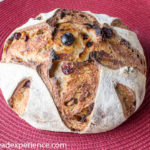Description
This Fruity Pain au Levain, with cranberries, raisins and walnuts, is naturally leavened and makes a lovely canvas on which to practice your decorative scoring.
Ingredients
Units
Scale
Levain
- 227 grams | 1 1/2 cups + 1/2 cup all-purpose flour
- 227 grams | scant 1 cup + 2 Tbsp water
- 45 grams | 3 Tbsp. sourdough starter
Final Dough
- 500 grams all-purpose flour
- 190 grams finely ground whole wheat flour (I used Graham flour)
- 375–400 grams water + 25 – 50 grams (to mix with salt) *
- 16 grams salt
- 45 grams organic sugar
- 55 grams walnuts, chopped
- 55 grams raisins
- 75 grams cranberries
Instructions
Day 1 – Mix the Levain
Option #1 Evening:
- Mix the water and starter together in a large bowl. Add in the flour and mix until completely hydrated. Cover with plastic wrap and let rest at room temperature for 8 – 10 hours.
Option # 2 Morning: (this is the method I used)
- Mix the water and starter together in a large bowl. Add in the flour and mix until completely hydrated. Cover with plastic or bees wrap, place on proofer or warm place (80-82 degrees F.) and proof for 6-7 hours.
Day 1 Evening or Day 2: Mix the Final Dough/Shape Loaves:
- Pour the water over the levain and mix thoroughly with a wooden spoon or whisk to disperse.
- Whisk the flours, salt, and sugar together and add on top of the water/levain mixture. Hold the walnuts, cranberries and raisins until after the autolyse.
- Mix thoroughly using a Danish dough whisk or wooden spoon to begin developing the gluten.
- Cover and let rest (autolyse) for 20 – 30 minutes.
- Add nuts, cranberries and raisins. Thoroughly mix and knead the dough using your fingers.
- Cover and let the dough bulk ferment for 120 minutes. Stretch twice, every 40 minutes. Let the dough rest for the final 40 minutes.
- Divide the dough, pre-shape, and then it bench rest (covered) for 20 minutes before final shaping to allow the dough structure to relax.
- Heavily dust lined or unlined bannetons with rice flour.
- Shape the dough into round boules and place seam-side up in the baskets. If you don’t have a proofing basket, place the loaf seam-side down on a parchment-lined baking sheet to proof.
- Proof for about 30 minutes at warm room temperature. Cover the loaves and place in the refrigerator to cold ferment overnight, 8 – 10 hours.
Day 3: Bake the Loaves
- Place a baking stone or steel on the bottom shelf of the oven and preheat to 450 degrees F. for at least 45 minutes. If you plan to use steam, place a steam pan on the top shelf.
- As an alternative, you can bake these loaves in a preheat bread cloche, Dutch oven or Dutch oven combo baker. (I baked these in a preheated ceramic bread cloche.)
- When the oven is sufficiently preheated, remove the loaves from the refrigerator. Carefully invert the loaves from the banneton proofing baskets (if used) onto parchment paper or a heavily dusted peel. I’ve found that using a lined basket aids with this process. You just carefully peel it off after flipping it over onto the parchment.
- Score the loaves in the pattern of your choice.
- Baking on Baking stone – Slide loaves onto the preheated baking stone and bake for 35 – 45 minutes. A larger loaf will take longer.
- Dutch Oven or Cloche baking – transfer the loaf on the parchment to the preheated Dutch Oven or cloche and place in the oven. Bake for 20-25 minutes with the lid on and 15-20 minutes with the lid off. Remove the parchment paper partway through the bake cycle to allow the bottom of the loaf to firm up.
- Remove the loaves to a wire rack to cool completely before slicing and serving.
Notes
* Adjust the hydration according to the type/blend of flour used. The addition of whole wheat flour makes the dough thirsty and the coarser the blend, the more water it soaks up.
Adapted from Richard Miscovich’s Pain au Levain from the book “From the Wood-Fired Oven”
- Category: Sourdough with Dried Fruit and Nuts
